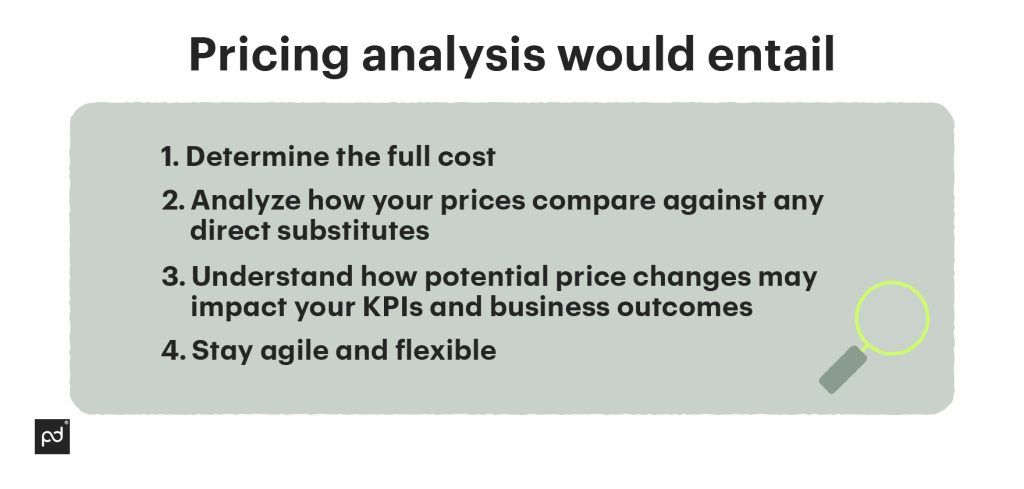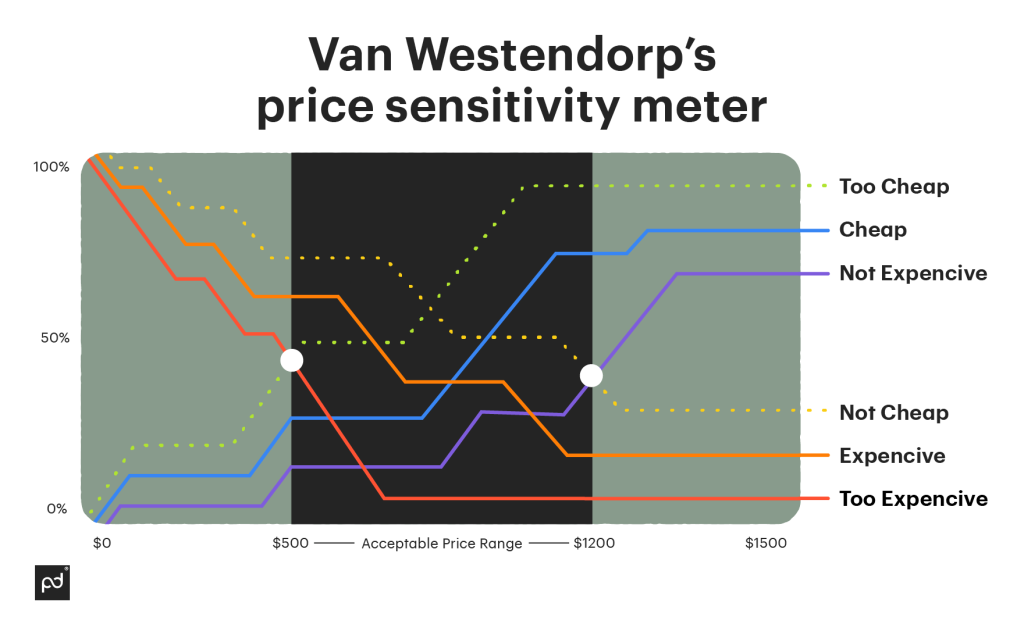Pricing is a major force that impacts all facets of your business operations.
No company will ever get it right all at once, which makes it so important to iterate and experiment with various approaches.
In this article, we go over the main pricing mistakes you should steer clear of in your efforts to optimize pricing and generate more sales.
At its core, there is a huge benefit in making your pricing strategy more dynamic and value-focused for a more interactive relationship with markets.
With that in mind, let’s review what not to do when it comes to pricing.
Pricing: a definition and business impact
The definition of pricing for each business, from retail to eCommerce, or even for Amazon merchants, boils down to:

This process is a fundamental part of product management, as well as one of the marketing Ps — whether you’re more likely to have four or seven of them exist in your view of the marketing world.
Generally, the price must always (sometimes not, but these are just a few weird exceptions that can be found) be dependent upon production, marketing, and operational costs, as well as taxes and all the other aspects making your price affordable for conducting business.
On the other hand, the price must correlate with the value proposition to be affordable for the buyer.
So, it’s crucial to adjust your prices carefully in order to keep your business up and running.
Your pricing, often along with how it is presented (especially for retail businesses), is a key factor that impacts your business viability and profitability.
It’s intertwined with the other two main components of your strategy — sales volumes and costs.
Investing time and effort in working out the kinks in your pricing strategies is as impactful as optimizing your costs and growing sales volume.
How pricing impacts your business
Pricing can influence how high your sales volume is at each specific price point.
In addition, it can help you generate higher profit margins that you can reinvest in improving your products, running robust R&D operations, and launching influential marketing campaigns.
Running an in-depth pricing analysis will deliver the valuable insights needed to make decisions on future pivots and adjustments.

Here’s a foundational sequence of actions that a successful pricing analysis would entail:
1. Determine the full cost
Determine the full cost that your product incurs by meticulous identification of all fixed and variable costs.
Go beyond the limits of the accounting definitions — such as cost of goods sold (COGS) and cost of sales — and dig deeper into the actual cost basis that should cover all of the related promotions, distribution costs as well as sales commissions.
2. Analyze prices
Analyze how your prices compare against any direct substitutes as well as adjacent alternatives.
Whenever a lead has a pain point, they’re willing to purchase any solution that matches their needs, be it a product just like yours or anything similar they can get their hands on.
3. Run focus groups and surveys
Run focus groups and surveys to understand how potential price changes may impact your KPIs and business outcomes.
Act carefully and record all of your insights to gradually form a robust suite of insights that will empower your long-term pricing strategies.
4. Stay agile and flexible
Continuously compare the “bang for the buck” that various pricing strategies bring.
Avoid fixating on any specific tack, and stay agile and flexible so that your business can quickly react to ever-changing markets.
Now that we’ve covered the basics, let’s turn to some of the major pricing mistakes you must prevent when running a business.
Learning about these mistakes in advance will undoubtedly save you a lot of time and headaches down the road.
1. Not segmenting the target audience
A key pricing mistake is failing to identify the distinct segments of the market that you seek to serve.
This hampers your ability to develop and implement your pricing strategy.
To quantify descriptions for your population segments, invest time and effort into collecting the relevant data.
Build out multiple buyer personas by eliciting various details about purchasing behaviors and preferred products.
Without a deep dive into customer segmentation, you’ll find it hard to arrive at the most profitable and attractive pricing terms.
2. Not relying on data for your pricing decisions
In many cases, companies base their pricing decisions on anecdotal data, gut feelings, or “guesstimation.”
Though this might work out for a certain period, you’ll soon find yourself dealing with more sophisticated rivals who use highly granular data to avoid pricing mistakes.
Market research should be your first step in gaining valuable insights into what your customers care about.
Make use of surveys and questionnaires to continue refining your architecture of customer segments.
Your users will love getting a complimentary gift or taking part in a lottery in exchange for filling out a quick survey.
A good idea is to combine such investigations with the data obtained from various analytical programs such as Google Analytics, Facebook Audience Insights, and others.
Next, keep on digging and run a MaxDiff analysis to pinpoint customers’ preferences regarding specific features and products.
This type of research technique employs a sharp focus on quantifying those preferences for the respondents at scale.
When applying the MaxDiff analysis, a researcher shows respondents a certain list of items, forcing them to rank those items from most important to least important from their perspective.
We can’t stress enough how much value your business will derive by empowering each and every aspect of your pricing decisions with data-backed analytics.
3. Not mapping out price sensitivities
Another major mistake in pricing your products is not learning what sensitivities your customers have.
The only way you can perform price sensitivity analysis successfully is to first mine insights on buyer personas and their preferences for products and features.
When you have this data, start running questionnaires developed based on Van Westendorp’s price sensitivity meter.

Such a survey should include questions on excessively high and low price points to delineate the minimum and maximum levels, as well as those price ranges that seem accessible and justified to your customers.
Aggregating the answers from specific groupings, you’ll gradually arrive at the averaged values for those price points that will capture the highest levels of interest and buying intent.
Enabled by the theoretical data, you can start experimenting “in the wild,” and see how responsive your customer segments are to your adjustments.
4. Relying too much on a cost-plus pricing strategy
You might be enticed by the allure of ease and convenience that the cost-plus pricing strategy brings.
Such an approach requires you first to calculate the cost of production/cost of revenue and then add up a fixed markup on all of the products or services you offer.
A seemingly straightforward process, the cost-plus pricing actually defeats your efforts to account for what your customers think about your offerings and how valuable they deem them to be.
With that being said, the cost-plus bases will set you up with quick-to-calculate foundation prices that you can then use in your value-driven refinements.
5. Betting too much on how your competitors’ price offerings
Considering how your competitors stack up against your offerings in terms of pricing, composition, and features is a powerful strategy that every management team should not slack on.
However, in many cases, you’d be better off figuring out your own unique path and go-to-market strategy.
A cooperative pricing strategy will help you keep track of the overall trends and sentiment in the market.
At the same point, you’ll have to split off from the herd and start calling your own shots.
An excessive reliance on cooperative pricing will limit your management’s wiggle room to lead the market and communicate the differentiating benefits that your product offers.
Another major pricing mistake is to act too aggressively when determining how much specific products should cost.
Looking up to (only) the key competitors, such companies would respond with deeper price reductions or keep them with no changes whenever strong moves come forward.
Such an approach can quickly get out of hand and result in all players chasing their respective tails with no clear purpose or destination.
6. Not elevating your offerings via exclusivity trigger and bundling
Mistakes are made when your team hasn’t invested enough effort in developing a powerful presentation of your products.
Adding a certain feeling of exclusivity and premium quality can easily allow your company to charge a much higher price point.
Even though your product stays the same, the context of purchase and consumption changes.
And such changes can significantly impact the perceived value that always has a powerful effect on how customers estimate the cost of your offering.
Another problem that teams have in their sales approach is not trying to bundle specific solutions with other products or complementary services.
Consider combining various items together so that you are able to offer an end-to-end solution to a cluster of customers’ needs and pain points.
7. Misaligned incentives for sales and management teams
A reduction in profits might be caused by misaligned incentives for your salespeople — your sales team might care only about the volumes without any attention given to the actual profitability that specific items bring to the table.
To solve this mistake in your pricing strategy, consider transparent and comprehensive communications within your teams and share the full scope of revenues and profits that each and every product generates.
When you tie KPIs to profits instead of revenues, your sales team will quickly realign their approach and push forward with profit leaders instead of going after low-margin sales.
In addition, your sales team might go down the slippery slope of using discounts and price reductions to attract buyers.
These tools deliver results only to a certain extent.
At some point, your brand will suffer from an unfavorable perception and your offerings will be seen as low-quality and risky.
Many buyers — and, in particular, B2B leads — are willing to invest sufficient resources and set up a solution that fully meets their needs as opposed to buying an effective product that they will end up replacing anyway.
8. Not allocating enough resources toward pricing management
As we’ve mentioned above, value-based pricing can be extremely beneficial to your sales volumes and profitability.
A frequent mistake that management teams make is not paying enough attention to pricing matters and how they may impact overall business dynamics.
Make sure that your management runs regular pricing meetings that dedicate the needed attention to adjusting your pricing strategy.
Make important decisions based on changing market conditions.
Relying exclusively on the hard data will allow your team to quickly see the major changes in the environment and work out ways to react to such changes.
9. Not focusing on your top 20% of customers based on profitability
As an extension of Mistake #1, this error means that customers disperse their attention across the overall pool of existing customers.
Though such an approach might seem fully viable, as it would allow businesses to generate profits and sustain operations, it makes companies more vulnerable to entreaties by competitors.
Those rivals who pinpoint the most attractive segments may deploy account-based marketing strategies to transform their overall marketing materials and communications strategies so that they better align with the key leads they talk to.
Importantly, it’s the profitability factor that should be the main criteria to segment customers into your Top 20% group.
Don’t consider the buying volume or the number of items purchased as the primary criteria, as sometimes the highest sales volumes don’t directly correlate to the highest gain in profits.
10. Not thinking through the long-term game plan
Developing a long-term strategy relating to your pricing and product lines is necessary to avoid chasing only short-term gains.
Your management team needs to see the long-term goals that they are working on so that they can reverse-engineer the local action plans.
Forecasting a potential response from your competitors should be an integral part of any strategy that you develop.
Consider dedicating special staff to continuously analyze and report on your steps and deliver probable feedback from your rivals in a standardized manner.
Combined with a focus on key target segments and elaborate strategies to analyze your customer base’s preference regarding products and features, thinking long-term will facilitate uplifting pricing and innovative pricing solutions — as opposed to turning to price reductions and dumping strategies.
Bottom line
Your pricing strategy should always stay agile and flexible in the face of continuously changing marketing conditions.
To avoid major pricing mistakes, consider running a deeper segmentation of your target groups and determining the inherent price sensitivities.
Value-based pricing strategy is a much more effective alternative to basing your pricing on cost-plus or competitive rationale.
Gaining insights into what your customers think about the value you bring to the table will allow you to see new ways to experiment with pricing and the components of your offerings.
In this way, you can gradually raise prices while seeing a positive effect on your brand image and profitability rate.
Start your price-related activities by writing proper pricing quotes.
Using PandaDoc’s quoting software and our comprehensive guide, you can do so flawlessly.
And you can begin your journey with a no-obligation 14-day free trial — it’s more than enough time to understand whether our software will address your needs to the fullest.
If you have any general questions, want to inquire about anything specific, or simply wish to learn more about PandaDoc products, feel free to contact us!
Disclaimer
PandaDoc is not a law firm, or a substitute for an attorney or law firm. This page is not intended to and does not provide legal advice. Should you have legal questions on the validity of e-signatures or digital signatures and the enforceability thereof, please consult with an attorney or law firm. Use of PandaDocs services are governed by our Terms of Use and Privacy Policy.

